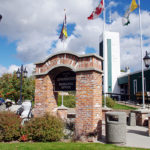Home »

May is Invasive Species Action Month in B.C.
 May 2024 has once again been proclaimed Invasive Species Action Month in B.C. The East Kootenay Invasive Species Council (EKISC) urges people across the region to get to know some of the invasive plants, animals, and insects causing significant local problems. Invasive species are one of the greatest threats to biodiversity, costing millions to manage each year.
May 2024 has once again been proclaimed Invasive Species Action Month in B.C. The East Kootenay Invasive Species Council (EKISC) urges people across the region to get to know some of the invasive plants, animals, and insects causing significant local problems. Invasive species are one of the greatest threats to biodiversity, costing millions to manage each year.
This month, we hope people in East Kootenay will learn to identify, report, and implement measures to prevent the spread of invasive species.
Invasive plants are those that have either been intentionally introduced because they look great or accidentally through soil movement. Invasive animals like Goldfish and Red-eared slider turtles end up outside of tanks, causing significant damage in the wild when pet owners release them.
Some of the invasive species you may have encountered in the East Kootenay region include:
Baby’s breath (lead image) (Common gypsophila) is an escaped ornamental plant native to Europe. It thrives in basic to neutral soils with full sun. Baby’s breath is frequently used in floral arrangements and if you have a bouquet including it, make sure not to dispose of it in the compost. When Baby’s breath invades grazing land, it reduces native grasses and forage for grazing animals and wildlife. When it develops seeds and matures, the plant breaks off at the ground and rolls long distances across the landscape with the ability to spread over 10,000 seeds per plant!
 Blueweed / Vipers Bugloss (Echium vulgare) is a hairy, painful to touch plant native to Europe, Western and Central Asia. Plants can drop up to 2800 rough seeds that can be further spread by clinging onto animals or humans. It can be found in dry, basic soils in grasslands, or alongside roads and railways. It is toxic to horses and cattle and reduces forage quality in rangelands and pastures, resulting in economic losses.
Blueweed / Vipers Bugloss (Echium vulgare) is a hairy, painful to touch plant native to Europe, Western and Central Asia. Plants can drop up to 2800 rough seeds that can be further spread by clinging onto animals or humans. It can be found in dry, basic soils in grasslands, or alongside roads and railways. It is toxic to horses and cattle and reduces forage quality in rangelands and pastures, resulting in economic losses.
Common Tansy / Bitter Buttons / Cow Bitter / Golden Buttons (Tanacetum vulgare) is a herbaceous plant that was introduced to North America in the 1600s for medicinal purposes. It is native to Europe and Asia. It spreads via roots and seeds that can remain viable for up to 25 years. Tansy is often found growing in sunny, disturbed areas such as roadsides or pastures where it can displace native vegetation. Infestations in rangeland can be toxic to livestock, and it’s reported that dairy cattle consuming the leaves often have unpleasant tasting milk.
 Hoary alyssum / False hoary madwort / Hoary berteroa (Berteroa incana) native to Europe, thrives in arid, disrupted environments like roadsides, railway embankments, and rangelands. It spreads rapidly due to its extensive seed production throughout a prolonged season. Seeds are disseminated by vehicles, machinery, footwear, wildlife, and birds, posing a risk of contamination to hay. Be cautious of Hoary alyssum if you have horses on your property, or you have hay crops. Once this plant gets into the hay, it can cause serious harm to the horses that consume it.
Hoary alyssum / False hoary madwort / Hoary berteroa (Berteroa incana) native to Europe, thrives in arid, disrupted environments like roadsides, railway embankments, and rangelands. It spreads rapidly due to its extensive seed production throughout a prolonged season. Seeds are disseminated by vehicles, machinery, footwear, wildlife, and birds, posing a risk of contamination to hay. Be cautious of Hoary alyssum if you have horses on your property, or you have hay crops. Once this plant gets into the hay, it can cause serious harm to the horses that consume it.
Leafy Spurge / Green Spurge (Euphorbia esula) is a high priority species in the East Kootenay! It is a perennial that was introduced to BC as a garden plant from Europe and has escaped into natural areas. It can now be found on dry roadsides, fields, grasslands, open forests, and disturbed sites. It spreads rapidly by its huge root system, which can grow to 4.5 m horizontally and 9 m vertically (underground). This plant has a secret weapon that helps it spread – it produces a chemical that stops other plants growing nearby.
Orange hawkweed / Orange hawk bit /Fox-and-cubs (Hieracium aurantiacum) have the ability to form dense mats, outcompeting native flora. Originally introduced from Europe as an ornamental garden species, they propagate rapidly through above-ground runners, horizontal roots, and prolific seed production. Agricultural and recreational activities, wildlife, and wind play roles in facilitating their spread. Remarkably, a single plant can yield hundreds of seeds.
Scentless chamomile / Scentless mayweed / Wild chamomile (Tripleurospermum perforatum) prefers moist soil conditions. It was introduced from its native range in Europe, Asia and North Africa. It can produce up to 1,000,000 seeds every year, and the seeds can survive in the soil for up to 15 years. This plant can aggressively take over pastures, grasslands, and other agricultural areas. If colonies form near riparian areas, the plants can easily crowd out other plants entirely.
 Spotted knapweed / Panicled knapweed (Centaurea stoebe) is a prolific seed producer, with individual plants producing up to 140,000 seeds per m2. This plant was unintentionally introduced from Europe and Asia. Seeds and plant fragments make their way into hay and the undercarriages of vehicles, allowing for new infestations over great distances. They can spread by wind, livestock, and people, preferring open areas and well-drained soils where they establish in grasslands, open forests, and along roadsides. Spotted knapweed is able to spread over large areas because of a secret weapon — an ability to release a chemical that kills surrounding plants. They choke out desirable forage for livestock and wildlife and increase soil erosion.
Spotted knapweed / Panicled knapweed (Centaurea stoebe) is a prolific seed producer, with individual plants producing up to 140,000 seeds per m2. This plant was unintentionally introduced from Europe and Asia. Seeds and plant fragments make their way into hay and the undercarriages of vehicles, allowing for new infestations over great distances. They can spread by wind, livestock, and people, preferring open areas and well-drained soils where they establish in grasslands, open forests, and along roadsides. Spotted knapweed is able to spread over large areas because of a secret weapon — an ability to release a chemical that kills surrounding plants. They choke out desirable forage for livestock and wildlife and increase soil erosion.
St. John’s-Wort (Hypericum perforatum), a perennial invasive plant, was originally brought from its native regions of Europe, Asia, and North Africa as both an ornamental and medicinal herb. It forms dense patches that can outcompete native vegetation, diminishing grazing grasses for animals. Its spread occurs through lateral roots, and each plant has the capacity to produce up to 100,000 seeds. Notably, St. John’s-Wort contains a toxin capable of causing skin burns or blisters in light-colored farm animals when exposed to sunlight.
Wild caraway / Meridian fennel / Persian cumin (Carum carvi) was introduced to Canada as a spice crop from its native range of Europe, Asia and North Africa but has since escaped cultivation. It is a biennial plant that can quickly outgrow native plants. It prefers to grow in rangelands, pastures, roadsides or disturbed areas but can tolerate light shade or excess soil moisture, as well as survive light frost.
Every year, the B.C. government proclaims May as ‘Invasive Species Action Month’, recognizing the impact of invasive species on B.C.’s environment, economy, society, and human health. This month, we hope you’ll get to know the simple, best practices that ensure we are all preventing the spread.
Gardeners can check out the Grow Me Instead guide for great alternatives to invasive plants. Boaters, anglers, and paddlers can learn about Clean Drain Dry. Hikers, bikers, and lovers of the great outdoors can discover Play Clean Go! And pet owners – please! Don’t Let it Loose, learn more here!
The East Kootenay Invasive Species Council is a non-profit organization that builds partnerships and supports collaborative projects in natural and applied science, policy research, outreach and education to protect our forests, fields, gardens, waterways and cities from the damaging effects of invasive species. There are two sides to EKISC, the Field side who are our boots on the ground doing invasive monitoring, treatment and inventories, and our Education side who provides outreach, training and resources to the public! More about who we are, what we do and your one stop shop for invasive species resources at www.ekisc.com
Photos submitted by East Kootenay Invasive Species Council
East Kootenay Invasive Species Council







